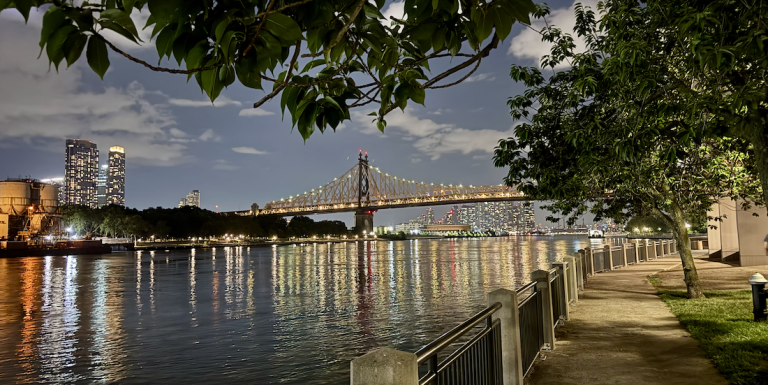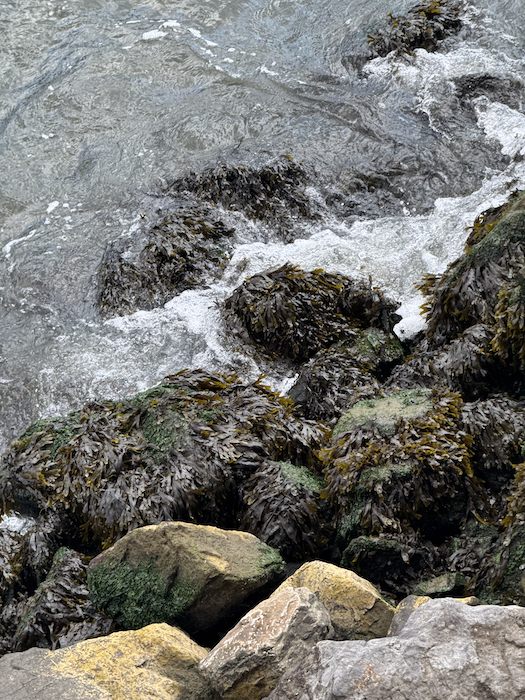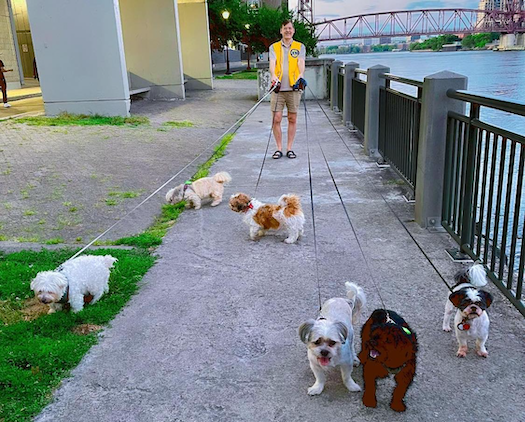
Enigma in the East River: A Journey Through Time and Transformation

New York, N.Y. — In the summer of 1995, before smartphones could instantly satisfy urban curiosity, exploration required genuine adventure. Each taxi ride across the 59th Street Bridge toward LaGuardia Airport revealed fleeting glimpses of something extraordinary below—a narrow strip of land nestled between Manhattan’s prestigious Upper East Side and the emerging skyline of Long Island City, Queens.
What lay beneath that mysterious canopy of trees and scattered buildings? In an era when the internet was still emerging from academic institutions and online searches were science fiction, satisfying this curiosity required action.
The Discovery: A Mystery Glimpsed from Above
The answer came through the Roosevelt Island Tramway, North America’s only commuter cable car and perhaps the most adventurous commute available to city dwellers.
Suspended 250 feet above the East River’s swift currents, the bright red cable car offered panoramic views of Manhattan’s skyline during its 3-minute journey across the 0.18-mile span.
As it descended toward the island, passengers left behind the relentless pulse of the metropolis for something unprecedented in New York City—profound quiet.
A World Apart: First Impressions of the Forgotten Island

Stepping off the tram in 1995 was like entering a different dimension.
This 2-mile-long, 800-foot-wide enclave felt frozen in time, a place apart despite sitting squarely in the heart of the world’s most powerful city.
The immediate vista was one of arresting juxtaposition: weathered, vacant buildings—remnants of a complex institutional past—stood sentinel over untamed fields where wild grasses swayed in river breezes.
It was simultaneously an urban explorer’s dream and a planner’s puzzle, desolate yet pregnant with possibility.
The island’s northern section revealed its living heartbeat through four distinct residential complexes that embodied deliberate socio-economic diversity.
Three developments were clearly demarcated for different economic strata—Rivercross for higher-income families, Island House and Westview for middle-income residents, Eastwood for lower-income New Yorkers.
A fourth and newer complex, Manhattan Park, carried an air of international intrigue as home to numerous U.N. diplomats and staff.
This blend of cultures and incomes created a unique microcosm of the city, yet the island’s isolation preserved an almost small-town atmosphere.
Ruins and Remembrance: The Haunting Southern End
The island’s most compelling allure lay at its southern end, directly facing the United Nations Headquarters across the water. Here, nature aggressively reclaimed human ambition through a landscape of Gothic ruins and melancholic grandeur. The skeletal remains of the Renwick Ruin – the Smallpox Hospital, designed by James Renwick Jr. (architect of St. Patrick’s Cathedral), brooded over the riverbank like a medieval apparition—something not quite believable in modern New York.
Nearby stood the vast, shuttered complex of Coler-Goldwater Specialty Hospital and the partial ruins of the Octagon Tower, once part of the New York City Lunatic Asylum. These weren’t sanitized tourist attractions but genuine ruins where ivy crept among gothic stones, marking both abandonment and the city’s quiet efforts to preserve its only landmarked ruin. Winding trails snaked around these relics, often completely devoid of other souls, creating an unforgettable dissonance—a secret garden of decay facing the global hub of diplomacy.
The eerie silence, broken only by wind and waterfowl, offered solitude that was unimaginable just one mile from Times Square. Walking these trails felt like discovering New York’s best-kept secret, a hidden drama playing out in plain sight yet invisible to most of the city’s millions.
The Decision: Claiming a Piece of the Secret
So immediate was the island’s pull that on a second visit, something decisive happened—an inquiry about apartments. In 1995, this meant boots on the ground, phone calls to the Roosevelt Island Operating Corporation (RIOC), paper applications, and patience. The process was analog, deliberate, and quintessentially bureaucratic in the way only New York could manage.
Securing housing on this experimental island represented more than finding an apartment—it was claiming membership in one of the city’s most unique communities. The four-year wait from initial application to apartment availability reflected the island’s desirability despite its seemingly isolated location. This wasn’t mass-market housing but a carefully managed social experiment in urban living.
Home at Last: The 1999 Arrival
In June 1999, a tangible piece of that persistent memory arrived—a physical letter bearing 10044 zip code. A three-bedroom, two-bathroom apartment in Eastwood was available for $1,200 per month, a steal compared to Manhattan’s $3,000 for similar space. The decision required no deliberation.
Moving to Roosevelt Island meant crossing the narrow Roosevelt Island Bridge from Queens, belongings transported by moving van into a world that still retained much of its sleepy, self-contained aura. The “F” Train subway connection, burrowing deep under the river, was reliable but didn’t bring throngs. The tram remained the iconic, if sometimes temperamental, gateway to this urban sanctuary.
Daily life involved navigating the single main avenue—Main Street—discovering the tiny commercial strip, and experiencing the profound quiet that descended after dark. Neighbors knew each other, at least by sight. Community events took advantage of natural amphitheater settings, and the island’s car-free environment fostered genuine relationships impossible in traditional Manhattan neighborhoods.
Evolution and Preservation: The Island Transforms
The subsequent decades witnessed a careful metamorphosis that balanced progress with preservation of the island’s essential character. The Octagon was meticulously restored into luxury apartments, its rotunda gleaming again. The crumbling Renwick Ruin was stabilized and illuminated, becoming a dramatic, officially recognized landmark that architectural historians describe as “an expression of an eerie romantic mood… a palpable documentation of a period in the past.”
New developments rose thoughtfully: Riverwalk Park (460 Main Street) offered glittering water views, Riverwalk Park (460 Main Street) brought additional residents, and Cornell Tech’s cutting-edge campus blossomed on the southern tip, injecting youthful energy and innovation. The crowning achievement came in 2012 with Franklin D. Roosevelt Four Freedoms Park, designed by Louis Kahn—a breathtaking memorial that transformed the island’s southern point into a serene, contemplative space of granite and sky.
The Enduring Magic: A Village in the Urban Sea
Despite undeniable evolution, Roosevelt Island retains its essential character as Manhattan’s quieter neighbor. It remains somewhat car-free, prioritizing pedestrians and cyclists along its full length. Green spaces like the lush Roosevelt Island Community Gardens and Southpoint Park offer vital breathing room, while the sense of community persists through events at the Roosevelt Island Public Library and gatherings at Good Shepherd Plaza.
The tramway, recently modernized, still provides that jaw-dropping aerial commute—a bucket-list ride offering panoramic views that remind residents daily of their unique perspective on the city. While no longer the desolate secret of 1995, the island maintains its distinct separateness. You step off the tram or subway, and the city’s roar softens. You walk paths where wildflowers push through cracks in old foundations, gaze at ruins silhouetted against gleaming skyscrapers, or sit in Four Freedoms Park feeling the river’s expanse.
A Living Testament: Layers of History, Dreams of Tomorrow
Roosevelt Island embodies New York’s capacity for reinvention and its commitment to diverse, sustainable urban living.

Here, history’s layers—from the original indigenous tribe the Lenape to the lunatic asylum, smallpox quarantines to U.N. families, urban planning experiments to tech innovation—remain palpably close.
It’s a place where 26% of residents are foreign-born and 35% of households earn below $50,000 annually, maintaining its commitment to socio-economic diversity.
The island represents one of New York City’s most successful urban renewal projects—a transformation from abandoned institutions to thriving community that continues influencing urban planners worldwide.
What began as curiosity glimpsed from a taxi window evolved into a model for car-free living that proves profound peace can exist in the heart of the Big Apple.
Living here feels like a privilege, offering urban access with suburban calm.
Morning jogs along the river, tram rides at sunset, and the ever-present Manhattan skyline provide daily reminders of why this narrow stretch of land in the East River captures hearts and imaginations.
The secret is out, but the magic endures—a testament to finding extraordinary sanctuary in the most unexpected places, a self-contained village improbably floating in New York’s urban sea, forever balancing its past solitude with its present accessibility.
Roosevelt Island remains what it has always been: Manhattan’s unassuming neighbor holding urban secrets, a place where exploration leads to belonging, and where the city’s best-kept secret continues revealing itself to those willing to look beyond the obvious.
About Roosevelt Island Today
- Location: East River between Manhattan’s Upper East Side and Long Island City, Queens
- Size: 2 miles long, 800 feet wide (147 acres)
- Access: Roosevelt Island Tramway, F Train subway, Roosevelt Island Bridge, NYC Ferry
- Notable Features: Four Freedoms Park, Renwick Ruin, Cornell Tech campus, car-free environment
- Community: Diverse residential complexes serving multiple income levels and international residents
Roosevelt Island: Our Home, New York City’s Hidden Sanctuary (Aug 14, 2025)
Summary
Roosevelt Island is New York City’s best-kept secret, nestled between Manhattan and Queens. Originally home to asylums and hospitals, its haunting ruins and tranquil paths now offer a rare retreat from city bustle. The iconic tramway delivers stunning views and quick access. For more than 25 years, the island’s unique blend of history, nature, and vibrant community life has attracted explorers and residents in search of unexpected serenity and depth at the city’s heart
#RooseveltIsland #HiddenNYC #EastRiver #NYCSecrets #UrbanExploration #NYCHistory #CornellTech #FourFreedomsPark #NYCTram #CityLife #NYCParks #NewYorkCity #NYCSecret #HiddenHistory #UrbanEscape #IslandLiving #NewYorkRetreat #HistoricRuins #GreatNYCViews #ExploreNYC #UrbanPlanning #CarFreeLiving #NYCHousing #ManhattanViews #NYCNeighborhoods #UrbanRenewal
Tags: Roosevelt Island, New York City, Manhattan, Urban History, East River, Roosevelt Island Tramway, Four Freedoms Park, Cornell Tech, Renwick Ruin, Octagon Building, NYC Parks, Urban Planning, NYC Neighborhoods, UN Diplomats, Coler-Goldwater Hospital, NYC Secrets, Community Living, New York History, Queens, affordable housing, Blackwell’s Island, Welfare Island, Smallpox Hospital, city planning, residential community, historic preservation, abandoned buildings, Octagon Tower, Main Street, NYC housing, urban development
